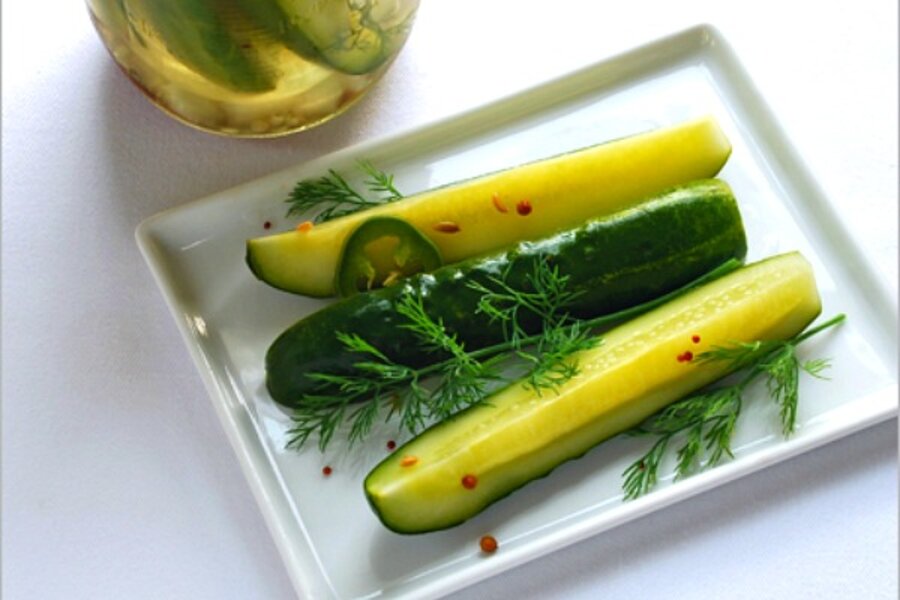The lazy man’s way to pickles: Fresh dill pickles need no canning
Loading...
A friend of ours is very good at blackjack. She’s actually gone on Caribbean vacations and stayed at casinos, where her daily routine has been to hit the tables for a couple of hours in the morning, long enough to make dinner and walking around money for the day, then head to the beach. She can do this fairly reliably. When incredulous friends ask why she doesn’t do it for a living, she says simply, “Then it would be work.”
This goes a long way toward explaining my lack of interest in canning, I think. I love to cook (I hope you can tell that much from my weekly ramblings here). But I love doing other things too. I’m not one of those people who fantasizes about spending an entire day in the kitchen. Canning, to me, involves a little bit of messing with food and a whole lot of work – much of it around boiling, steaming cauldrons of water.
That scenario clashes with my desire to do other things. And, if we’re being totally honest, a certain amount of laziness. When I was a kid, some get-rich-quick scheme ran ads in the backs of comic books with the headline “The Lazy Man’s Way to Riches.” I can’t remember the gist of the scheme (and I’m sure the only one who got rich from it was the guy running the ads), but taking “the lazy man’s way to riches” became my code for taking shortcuts. Repairing something with duct tape. Cramming clutter into the spare bedroom moments before company arrives.
Or in this case, making pickles without canning them. The first time I heard about fresh pickles, marinated overnight or over several days in vinegar and herbs and spices, but not officially canned, it was an epiphany. No, you didn’t have something that would last through the winter ahead, but you had something you could eat almost immediately – crunchy, tart, tangy and open to all kinds of interpretations. And you didn’t have to boil a single jar.
There are countless variations on making fresh pickles (or refrigerator pickles, as they’re also called). They include salting the pickles beforehand, then rinsing them, to increase their crunchiness (honestly, since you don’t cook these pickles to bring them to safe pickling temperature, they stay satisfyingly crunchy without this step). You can mix vinegar, water, salt and sugar in a jar and just shake it until the salt and sugar dissolve. You can use hot tap water to aid in the dissolving. Or you can heat the vinegar to a boil with the salt, sugar and some of the aromatics to enhance their flavor. That’s what I did, taking a slightly less lazy man’s approach, I’d like to think.
What follows is a bonafide recipe, with accurate measurements and all the steps spelled out. But please feel free to use it as a jumping off point and tinker away. As created below, the pickles are crisp, flavorful and lively, packing only the slightest hint of heat. And what they are not is salt bombs, as many commercial pickles are.
The one ingredient you do need to find is the right cucumbers. What you want is short, stubby Kirby cucumbers. They may also be called pickling cucumbers or, as they were labeled at the produce market where I found mine, fresh pickles. They are not waxed like their larger brethren, and they’re nicely pickle sized.
Fresh Dill Pickles
Makes 16 pickle spears
1-1/2 cups distilled white vinegar (see Kitchen Notes)
3 tablespoons sugar
3 teaspoons kosher salt
1 teaspoon coriander seeds
1/2 teaspoon mustard seeds (I used brown mustard seeds)
1/2 teaspoon fennel seeds
1-1/2 cups water, plus extra
4 Kirby cucumbers, about 1 pound total
1 jalapeño pepper, sliced into thin rings
3 to 4 cloves garlic, coarsely chopped
12 sprigs fresh dill (plus more, if desired)
Special equipment: 2 wide-mouthed jars tall enough to accommodate the cucumber spears.
Combine vinegar, sugar, salt and coriander, mustard and fennel seeds in a medium sauce pan. Bring the vinegar to a boil over medium high flame, stirring frequently, until sugar and salt dissolve. Remove from heat and cool completely.
Wash and dry the jars. Rinse the cucumbers carefully and pat them dry. Quarter the cucumbers lengthwise and pack slices into the jars. Divide the chopped garlic and jalapeño slices between the jars, tucking between the cucumber slices. Tuck 6 sprigs of dill into each jar.
Add 1-1/2 cups of water to the vinegar. Divide vinegar mixture between jars, making sure the seeds get divided as well. If necessary, add a little water to completely submerge the cucumber slices. I added about 1/4 cup to each jar. Close jars tightly and shake to mix in added water. Refrigerate at least 24 hours before eating. Pickles should keep up to a month refrigerated.
Kitchen Notes
Vinegar variations. Distilled vinegar gives these pickles a sharp, clean flavor. It also preserves the pickles’ beautiful emerald green color; cider vinegar would not. You might also experiment with white balsamic vinegar or white wine vinegar. Some recipes even call for a mix of white vinegar and white wine; keep in mind that the wine’s alcoholic content would still be present in this mix.
Related post: Marion's Asian Slaw





